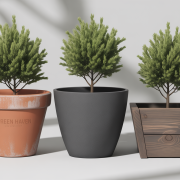In the digital age where work, life, and socializing have increasingly become digitalized, walls of glass and steel seem to be what define modern cities. Our lives can feel disconnected from nature but thanks to a new movement in interior design – called biophilic design – that is about to change.
Biophilic design has been gaining momentum over the past few years as more people are beginning to recognize its many benefits. It seeks out ways of connecting interior spaces with their surrounding environment resulting in an atmosphere that not only looks beautiful but also brings you into closer contact with nature.
In this blog post, we will explore what biophilic design is, why it’s becoming so popular and how you can incorporate it into your indoor living spaces.
History Of Biophilic Design
But what is biophilic design, and how did it come to be? The term “biophilic design” was coined by American psychiatrist and psychoanalyst Dr. Edward O. Wilson in the 1980s.
Wilson argued that humans have an innate desire to connect with nature and that this connection has a positive impact on our well-being. Biophilic design seeks to fulfill this desire by bringing elements of nature into the built environment.
The concept of biophilic design has been around for centuries. In ancient cultures, homes were often built using natural materials and were integrated with the surrounding landscape. Even in modern times, architects and designers have long recognized the benefits of incorporating nature into design.
For example, Frank Lloyd Wright’s Fallingwater house in Pennsylvania is a prime example of biophilic design, integrating natural elements such as stone, water, and vegetation.
Today, biophilic design is more popular than ever.
It’s not hard to see why – with increasing urbanization and the proliferation of technology, many people feel disconnected from nature. Biophilic design is one of the latest interior design trends that offer a way to reconnect with the natural world, even in the most built-up environments.
Elements Of Biophilic Design
So, what are the key elements of biophilic design? Let’s take a look:
Natural Materials
First and foremost, natural materials and finishes are an integral part of biophilic design. Wood, stone, and plants are all commonly used to bring a sense of nature into the home.
Natural Light
Natural light and views of nature are also important elements. Access to sunlight has been shown to have numerous health benefits, and being able to see and connect with the outdoors can help reduce stress and improve overall well-being.
Water
Water features and elements of the movement are also vital components of biophilic design. The sound of running water has a calming effect and incorporating a water feature such as a fountain or indoor pond can bring a sense of tranquility to a space.
Similarly, elements of movement such as a hanging plant or a ceiling fan can help create a sense of motion and bring the outdoors inside.
Nature-Inspired Colors And Textures
Color and texture also play a role in biophilic design. Using shades and tones that mimic nature, such as earthy greens and blues, can help create a sense of connection with the outdoors. Textures such as wood grain and stone can also bring a natural feel to a space.
Incorporating Biophilic Design Into Your Home
Now let’s get to the most important part of this article, how can you incorporate biophilic design into your home? There are plenty of small-scale and large-scale projects you can undertake. Incorporating natural elements into different types of spaces can be a great way to bring the outdoors in and create a sense of connection with nature.
In the living room, for example, you could add plants and use natural materials such as wood or stone for decor. You could also incorporate natural light by adding skylights or large windows. In the bedroom, you could use wood or bamboo for flooring and bring in plants to add some greenery.
For an outdoor space, consider creating a natural oasis with plants, water features, and natural materials such as wood or stone. Don’t be afraid to get creative and think outside the box – there are countless ways to bring the outdoors in and create a space that feels connected to nature.
Whether you are looking to liven up your living room, enhance the atmosphere in a bedroom, or transform your outdoor space into a tranquil oasis, there are many ways to do so. Start by adding natural elements.
You can do this by strategically placing potted plants around the room, and hanging nature-themed art or furniture featuring natural fibers like cane and rattan; this may help to create a warm, inviting atmosphere for you and your guests.
Another great way to bring the outdoors inside is to incorporate natural light with expansive windows or skylights.
The importance of incorporating both views of nature and opportunities to interact with it is often overlooked – bringing natural elements into spaces where people spend time not only looks aesthetically pleasing but helps us feel more grounded, relaxed, and connected with our surroundings.
It’s important to note that biophilic design doesn’t have to be expensive. There are plenty of budget-friendly options for incorporating natural elements into your home. For example, you can use inexpensive materials such as bamboo or cork for flooring or use thrift or vintage pieces to add a natural touch to your home.
In conclusion, biophilic design is a trend that shows no signs of slowing down. The principles of biophilic design provide a way to heal the rift that has developed between us and the natural world. By bringing nature into our buildings and homes, we can reduce stress, increase productivity, and promote well-being.













Comments